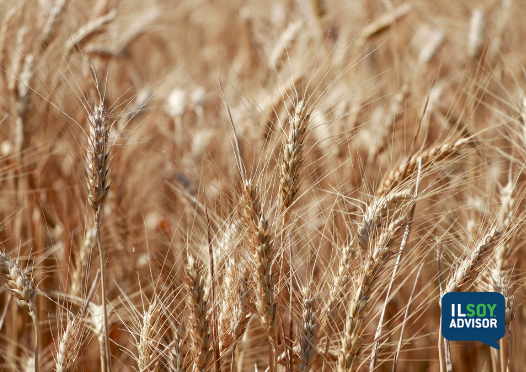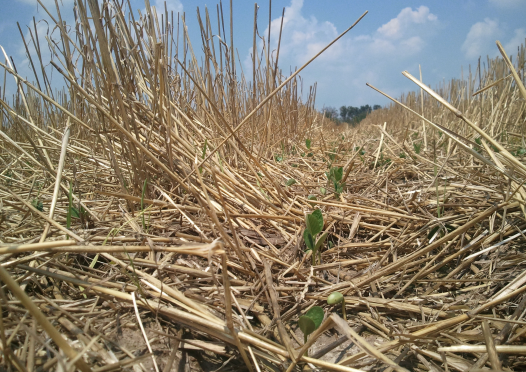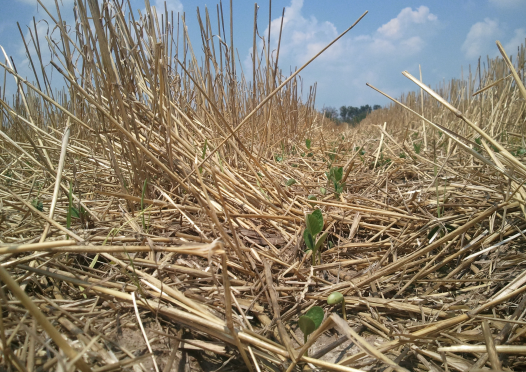ILSOYADVISOR POST
Agronomy: Getting The Most Out of Your Acres
Another alternative to planting corn is double cropping soybeans after wheat. Steve Jobs, the founder of Apple, once said “Your time is limited so don’t waste it living someone else’s life. Don’t be trapped by dogma—which is living with the results of other people’s thinking.”
Thanks to a lifetime in the ag industry and a career that has blessed me with the opportunity to work with farmers from coast to coast—from the borders of Florida to within a few hours of Alaska—I have seen a lot of different recipes for success. Perhaps the most important thing I have learned is that the laws of physics, chemistry, biology and math do not change no matter where you live. The other thing I learned is not to be “trapped by the results of other people’s thinking.”
Double cropping is an alternative to corn and squeezes more profit out of your acres. One of the most familiar and easiest options to consider is a corn, soybean, wheat, double crop soybean rotation. Maybe even leave out the corn. There are some huge environmental and soil health benefits to consider. Yes, I know those benefits are not seen in the bank account for a long time, so let’s set those aside for another discussion. You already know there are financial advantages. There is not much in the way of an increase in land, equipment, seed or labor costs.
Yeah—you tried double cropping before and it didn’t pay—so why now? What’s changed?
Let’s start with knowledge and support. We have instant access now to extremely good advice on all phases of this rotation from appropriate wheat and soybean varieties to soil nutrition, residue management and crop protection. We have varieties and crop protection products and access to equipment that we never had before. Many farms have on-farm drying systems, as well as access to markets that will purchase high moisture wheat (within limits).
Almost everyone has some form of vertical residue management tool of some description with some tillage ability to handle the wheat residue.
All combined, we now have the opportunity to apply more best-management practices to the problem of yield-limiting factors than we have ever had in history.
Get your team together and make a plan. Assess the yield-limiting factors and prioritize them for your farm. You will need to make time your number one priority and if you do not have irrigation you will need to make moisture your number two priority, no matter where you live. Since you are seeding soybeans later into warmer and drier soil, you need to conserve moisture.
Speed everything up. Doing soil tests, controlling weeds and applying soil amendments at wheat planting time begins with the wheat crop and continues into the soybean crop with a burndown followed by a post. Plant early maturing varieties of wheat and soybeans.
Get your wheat harvested quickly. Start at 20%—maybe even 22%. Cut the stubble high because you want to get that combine out of the field as fast as you can. Stripper heads are great for cutting early and leaving tall stubble. Follow the combine with a vertical tillage tool and get that residue cut and down because it is bleeding off all the moisture that’s still in the root system. Also, when the residue goes down it shields the soil from the sun. Wheat residue mixed with a bit of soil forms a mulch-like insulation that traps moisture that is evaporating from the soil. With the residue mulched, the emerging soybean plants are not shaded by the stubble, so they start with maximum photosynthesis right away.
Plant in the narrowest possible row for several reasons. The faster you can canopy, the better you will control weeds—you will shade the ground quickly to reduce moisture loss which will keep the root systems cooler. The crop will capture the maximum amount of carbon dioxide that is exhaled by the soil. Remember the role of C02 in plant growth and development? From biology we all learned that C02 + H2O + sunlight in the presence of chlorophyll = photosynthesis. Air is only .04% C02—but the soil is exhaling CO2 at a whopping .25%.
We have all noticed how quickly a crop transforms once it canopies. That comes partly from moisture conservation, partly from root system cooling and partly the more efficient and greater harvest of C02.
If you only have a planter—I hope it is 15”—you can double plant back in 7.5’s. That will serve to get the residue down and mulched. If you have a drill that is good, the narrower the better. Don’t forget to get that residue down and make sure you calibrate it correctly so you are not pouring seed into the ground that you don’t need. That wasted seed cuts hard into your profit.
If you have a vertical tillage tool you might want to try it. Broadcast both crops—wheat and soybeans—and work them in with the vertical tillage tool. It is a no brainer with wheat, just make sure the seed is covered. With your double crop beans, you will need to make absolutely sure the seed is covered with soil and a good mulch. Hopefully a rain will follow soon after.
Remember what I said about time, moisture and carbon dioxide. The vertical tillage tools win all three contests. Ideally you should use an air cart towing the vertical tillage tool with a broadcast or banding kit because you can take care of the fertilizer and seed at the same time. Do not use a spinner spreader for either wheat or soybeans. Use a Valmar, Gandy or the Coop’s pneumatic delivery system.
Stay away from a spinner box because it results in an uneven wheat and soybean stand and you will lose 30% to 40% off the soybean germination percentage.
I know you’re all saying “what about seed to soil contact?” Seed to soil contact is a catchall phrase that has been around for a long time. It is the short form for all of the elements that need to line up for seed to germinate. Those elements being survivable temperature, protection from radiation and the presence of water vapor, oxygen and light. You all know that you do not need soil to germinate seed because all of you have done so on a paper towel, blotter or something that provided that seed with the 5 elements necessary for germination.
Then there are those who want to market straw and apply manure. All I can say is if you are going to do it—do it fast—because in most parts of North America, for every day you delay planting after July 1, you can kiss a bushel goodbye.
If you want to discuss further, I am easy to find.




Comments
Add new comment